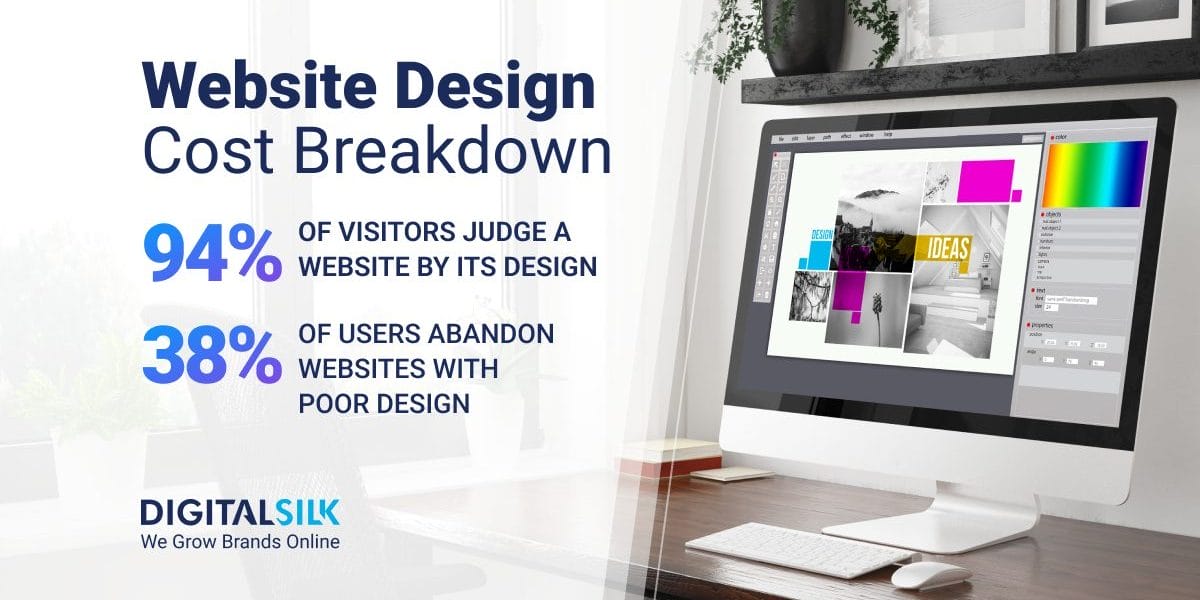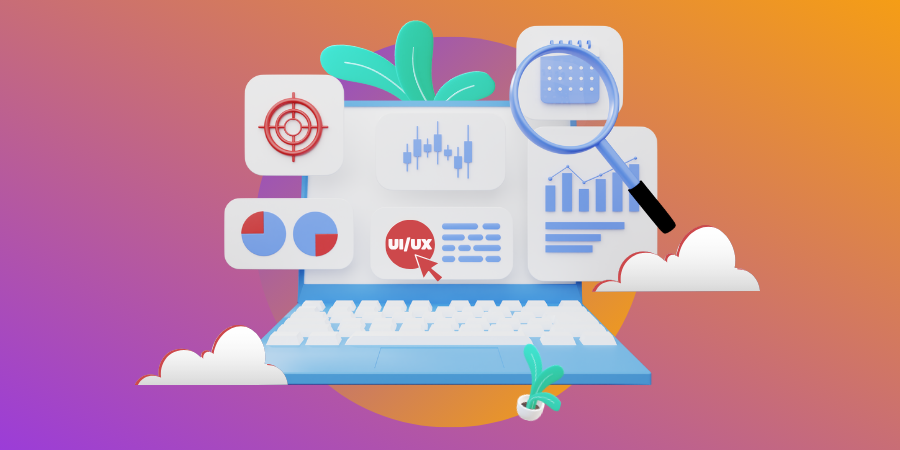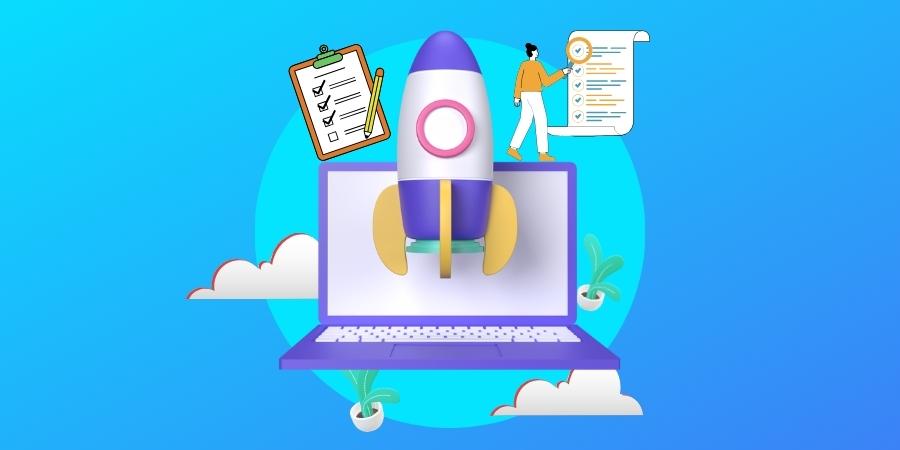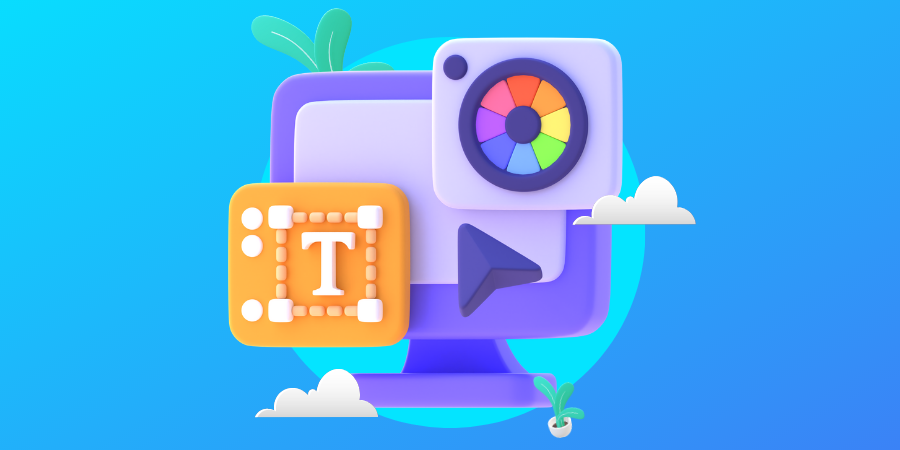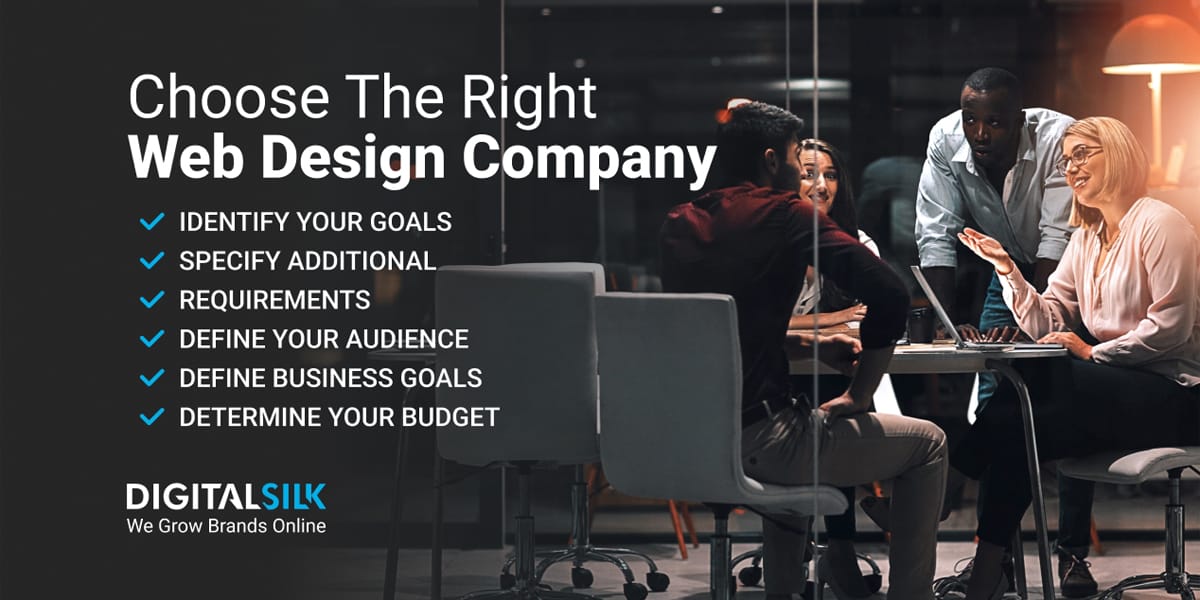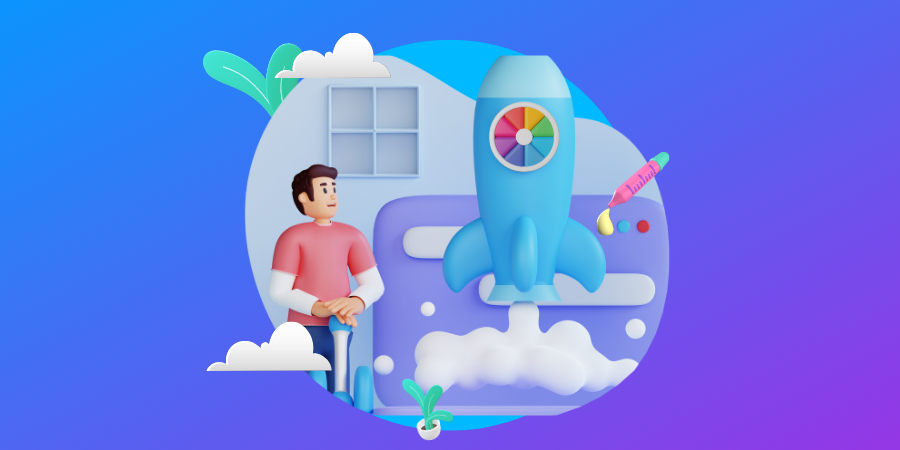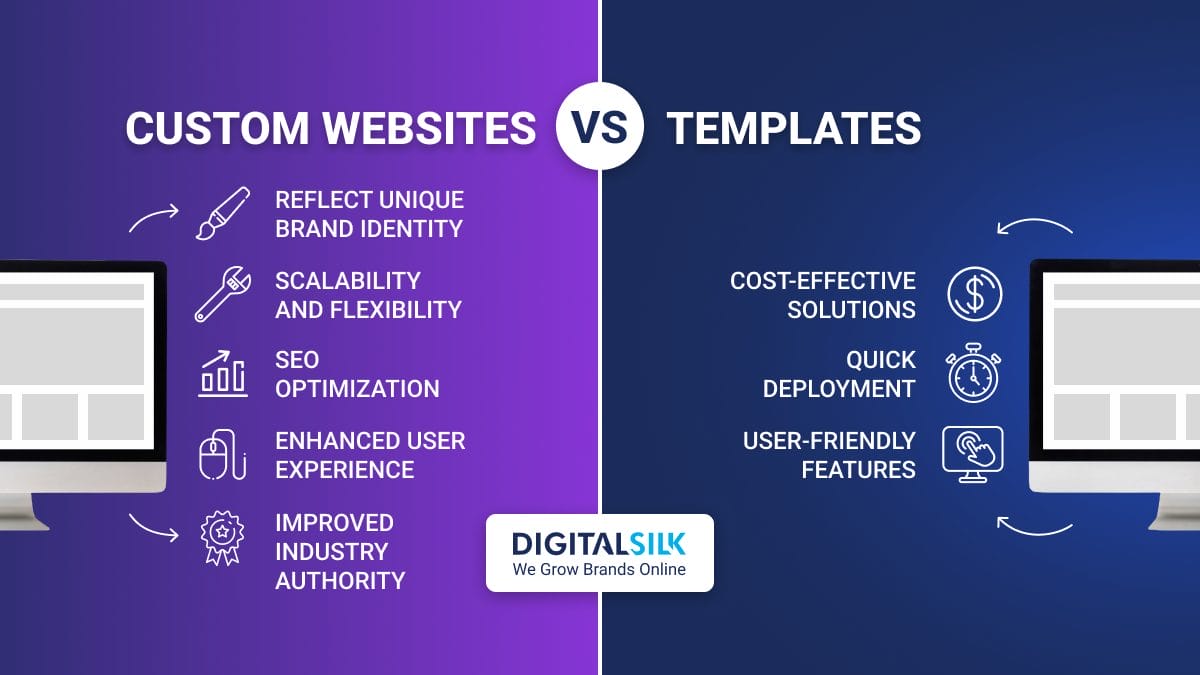94% of the time, visitors form an opinion about a website based on its design.
Whether you’re looking to build a website for your startup, create a digital presence for your e-store or modernize your existing site, a custom website design can offer numerous advantages in terms of functionality, user experience and security.
But how much exactly does a custom website design cost?
We’ll break down the factors that determine the cost, so you can get a ballpark figure on the investment that a tailored and unique digital presence requires.
Digital Silk creates custom websites. Request a Quote
How Much Does A Custom Website Design Cost In The U.S.?
The size and the type of your business will determine the size and the type of your website, which means that starting website prices can vary significantly.
For US-based web design companies, pricing structures for a custom website may look like this:
- A custom business website for startups that consists of a few pages and doesn’t have too much information will typically not require excessive work or customization. For a website that contains less than 15 pages – such as an About Us page, blog, services, homepage, stock images and functionalities that are not overly complex — the cost might range from $25,000 – $30,000.
- A mid-size custom business corporate website of up to 75 pages, a content management system (CMS), custom layout and a few unique functionalities may cost between $50,000 – $60,000 and up.
- A large custom business corporate website that has hundreds of pages, a fully customized design, CMS, blog content and multiple unique functionalities such as live chat, could start at $100,000 and go up from there.
- A custom eCommerce website can, depending on the complexity of the online store, require copywriting and a large number of products and cost around $100 per hour or more.
Use our free website cost calculator to get a more precise estimate for your project based on your specific needs.
Factors That Affect Custom Website Design Cost
Custom website design cost depends on several factors, such as the design elements, number of web pages, messaging and more.
Knowing what affects the cost of custom website design will help you make informed decisions about your allocated budget.
The factors that can affect the cost of your website include:
1. Templated Or Fully Custom Approach
When it comes to website design, businesses often need to choose between a templated design or a fully custom approach.
Both have their merits and drawbacks and the choice largely depends on various factors including budget, timeline and specific needs.
Below is a brief overview of each approach to help you make an informed decision:
Option 1. Templated Web Design
A templated web design can help you save time compared to building a web design from scratch and it will cost less. However, there are drawbacks when utilizing a templated design.
For example, templates usually come with fixed layouts and styles, and extensive customization might be challenging. You may require coding skills to modify the template beyond its original design.
And that’s only scratching the surface.
Using a template for web design can pose security vulnerabilities, such as insecure file uploads and the lack of cross-site request forgery (CSRF) protection, where attackers can perform actions on behalf of an authenticated user, leading to potential data manipulation or unauthorized transactions.
Option 2. Custom Web Design
A fully custom, unique website design can take longer to build and it will require costs upfront, but it comes with a variety of benefits.
With a custom web design, you have the freedom to create a unique look and feel that’s completely aligned with your brand. This can give you a distinct edge over competitors who might be using off-the-shelf templates.
38% of users abandon websites with poor design. Custom web design allows you to curate the user journey and experience based on your specific audience and business goals, leading to higher engagement and potentially, higher conversion rates.
As your business grows, a custom site can be adapted to include new features or functionalities, unlike many templated solutions that come with limitations.
When it comes to security, custom-built websites can include special security features, such as custom firewall rules, security event logging and intrusion detection and prevention systems, to improve your website’s protection.
With a custom website, you can also schedule regular security updates to address any vulnerabilities, ensuring that your site stays ahead of security threats. You’re not dependent on a third-party vendor to provide these critical updates.
Ultimately, an intentional and strategic custom website yields better results.
Our experts can help. Schedule A Consultation
2. Number Of Website Pages
The number of pages on your website has a direct correlation with the amount of work required in designing and developing the site. More pages typically mean more design layouts, more content to populate, and additional time for coding and testing. This usually translates to higher costs.
eCommerce websites with an extensive line of products may require hundreds of web pages, for example, while simple, corporate websites may only need 5-10 pages in total.
If you need to have various page layouts — think blog posts, product pages, calendar displays or regular content pages — they will also need to be designed, increasing the final price.
3. Design Elements
The overall cost will also depend on the complexity of the elements you want to add.
For example, some design elements include:
- Parallax effect: Parallax effect can help create a dynamic and engaging user experience by allowing different elements on a web page to move at different speeds as the user scrolls through the website.
- Motion graphics: Motion graphics are pieces of website animation where text, images, illustrations, video and sound are combined to create a dynamic visual experience.
- Lazy loading: Lazy loading is a web design trend where specific elements, such as images, are only loaded when they are needed or when they become visible in your user’s viewport. This design element can significantly improve the performance and loading times of your website, providing a more responsive user experience.
We recently designed Welch’s Fruit Snacks’ MX (a food company) website and implemented design features, such as 3D animations, in the form of floating fruit snacks.
Using 3D animations on a food website can create a visually immersive experience that helps bring the products to life, making them more enticing to potential customers.
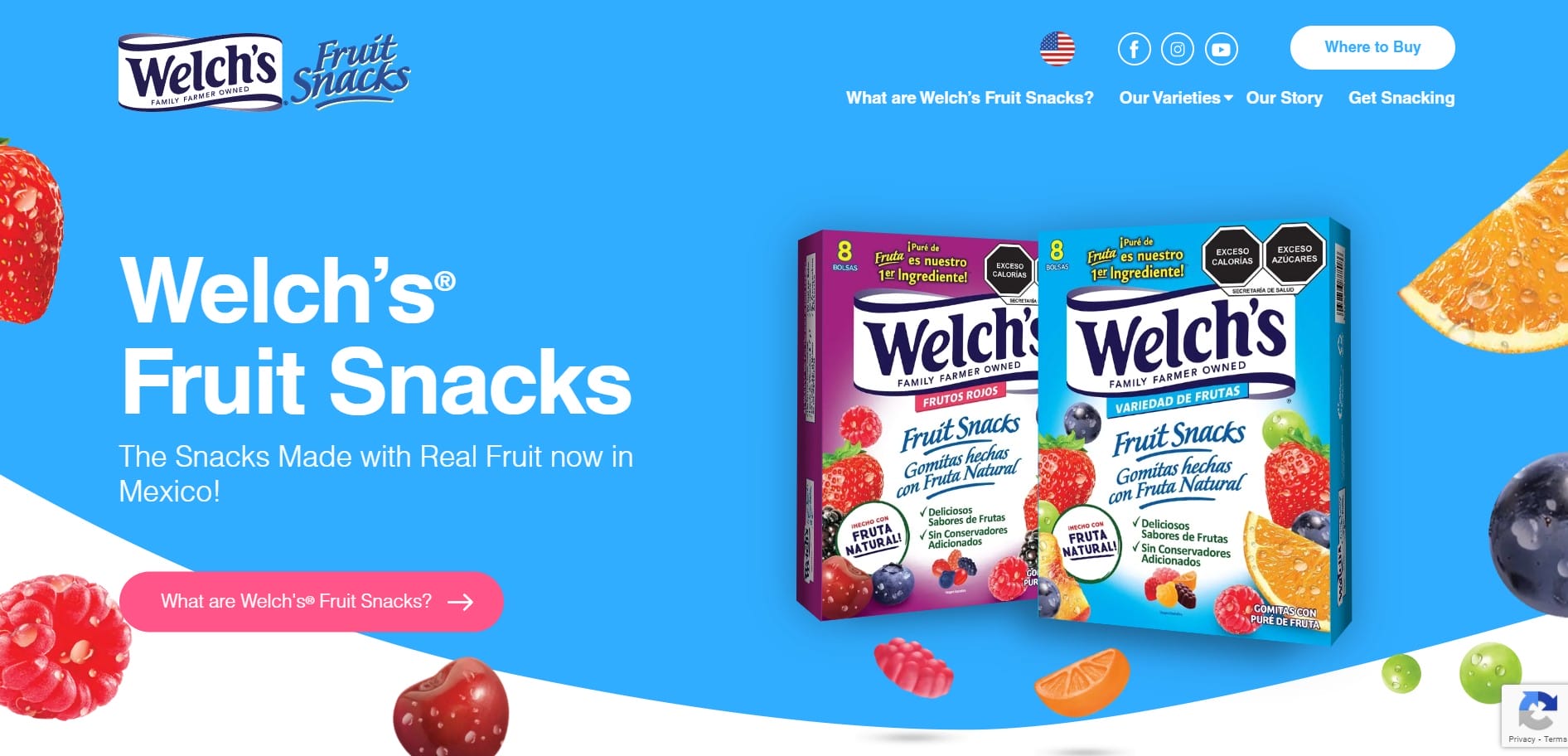
[Source: Welch’s Fruit Snacks]
4. Website Messaging
Messaging is an important component of your website and its user experience, whether it’s on your home page, product pages or landing pages for new launches, sale offers and other promotions.
Why?
Effective messaging clearly conveys your brand’s value proposition, mission and offerings to your visitors, helping them understand what your brand and offerings are about.
Effective messaging can also help foster engagement, guide users through your site with purpose and directly contribute to achieving your goals, such as building trust with your audience.
A full-service agency usually employs copywriters as part of its comprehensive offering to clients.
Copywriters are responsible for crafting compelling copy for various marketing materials, such as websites, press releases, email campaigns, social media or blog posts.
Most agencies charge for their copywriting services either by hourly rates or the scope of work needed for each website page.
We helped Rollink — an innovative luggage e-shop — to strengthen its messaging.
Right above the fold, the user quickly sees what Rollink offers — collapsible luggage. They don’t have to scroll down to understand its unique value proposition (UVP).
This messaging strategy is effective in a competitive market where brands should stand out from their competitors.
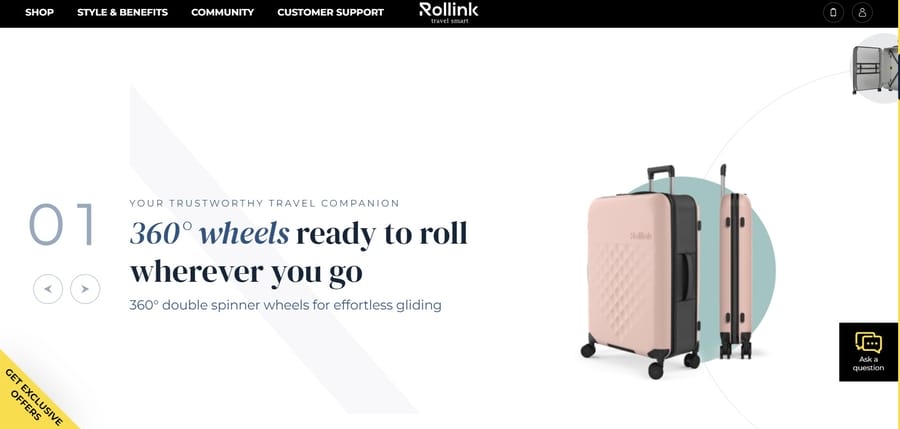
[Source: Rollink]
5. Website Functionalities
The features that your website will offer aren’t just crucial for user experience; they also play a significant role in determining the overall cost of your custom website design project.
The possibilities are endless — from member forums and registration systems to chatbots, in-depth calendars and booking features.
The more of these features your website requires, the more complex the design and development will be — and therefore, the higher the price.
For example, if you live in California, there are various things to consider. So before selecting your web design company, make a list of all the required functionalities your California brand needs. This will help the web design agency estimate the scope of the project and its cost.
In addition, here’s an example of a feature you might want to consider adding to your website. We integrated a chatbot for Ventura Foods — an American-based food company that specializes in producing and distributing a wide range of edible oils, dressings, sauces and other food products.
Brie The Chatbot serves as an automated customer service representative, providing instant responses to their users’ queries. This interactive feature enhances user experience and helps in lead generation by engaging potential customers in real-time.
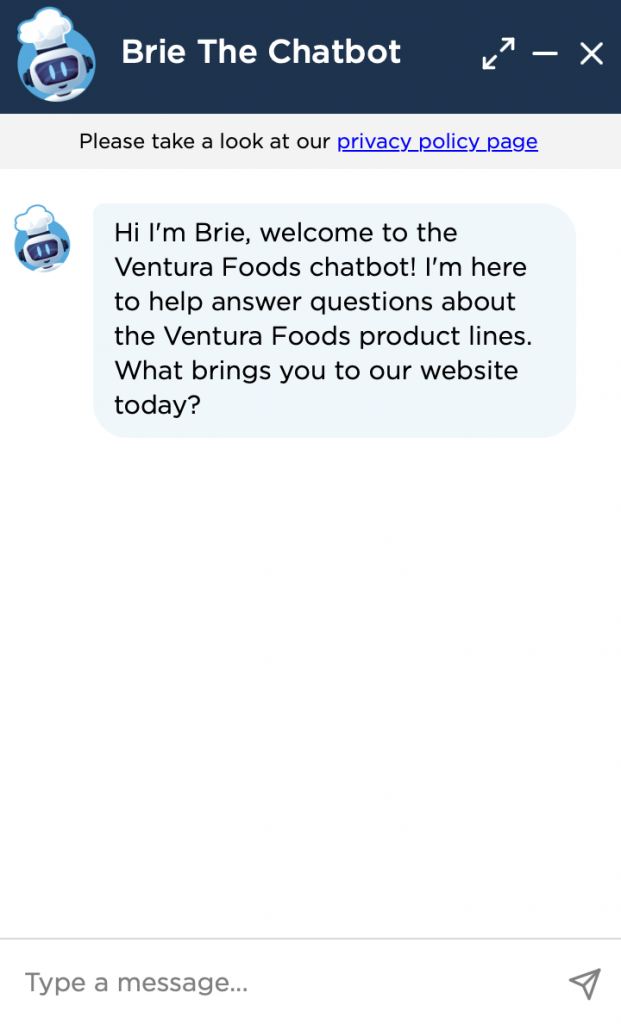
6. Website Integrations
A well-designed website is more than just a collection of pages; it’s a hub where various digital streams converge.
From tracking user behavior with analytics tools to managing customer relationships through a CRM, website integrations add layers of functionality that can make your site more powerful and user-friendly.
At the same time, website integrations can significantly impact the overall cost of a website project, as they often require specialized development work and potentially ongoing subscription fees for third-party services.
For example, eCommerce websites would require a support ticketing system, a customer relationship management system for sales teams, inventory tracking systems for sold products or other functionalities.
7. The Web Design Agency’s Expertise
Working with an agency that has an experienced team of designers and developers does come with a higher cost, but it ultimately ensures your website project is a successful one.
Look for a web design company that specializes in your particular business niche and has a successful track record of designing profitable and attractive websites in your field. An agency’s portfolio review will give you insights into their design style, technical proficiency and ability to handle complex projects.
The team you trust with your site should fully understand your market, your industry and your target audience and be able to design your website with these factors in mind.
Top agencies have well-developed and tested web design processes that they follow for delivering the best results. These include:
- Website planning
- Setting website goals
- Digital strategy
- Prototyping and wireframing
- Development and design
- Testing
The more thought and process an agency invests into your website project, the better the end product will be.
This also means that the project will come with a higher overall cost, as more time and energy will go into it.
8. The Web Design Agency’s Rates
If you spend $10,000 on a website and it doesn’t generate leads or sales, it’s a waste of time and money and lost opportunities.
Case in point: We have a client who spent $150,000 on an eCommerce site. When the site was launched, the following month, sales went from $300,000 to $1.2 million. Their monthly sales quadrupled and have been increasing consistently, month over month.
So it depends on some factors including if your agency is aware of the local market. For example, if you live in Miami it’s always a better idea to consider a web design agency based in Miami rather than find a remote web design solution.
The issue is that here some will look at a price tag and think “That’s too expensive.”
But others will value it differently.
Remember: The price is not most important ― the results are.
With that being said, we understand that not everyone has access to the sums needed to build a custom site. If your budget is tight and you’re seeking a site with limited features, you can start with a template.
However, we strongly advise against that.
Our Custom Web Design Process At Digital Silk
Now that you have an overview of the costs to consider, it’s important to understand the proper web design process of building a custom site so you are not left in the dark about what goes behind the scenes.
Here is our custom web design process at Digital Silk:
1. Onboard & Plan
Understanding your brand, project objectives, audience and competitors enables us to set a foundation for upcoming research and tactical planning for the website.
- Discovery: We learn about your business, conduct a company analysis and research your competitors. This step allows us to gain a deep understanding of your industry landscape, target audience and UVPs. Equipped with this knowledge, we can then craft a custom web design strategy that aligns with your business goals and sets you apart from the competition.
- Messaging and planning: Before jumping into design, we understand your target audience, their needs and their behavior so we can plan your conversion funnel. By mapping out the conversion funnel early on, we can strategically position calls-to-action, optimize user flow and create a cohesive experience that drives engagement and conversions.
2. Design & Develop
From the backend to the frontend, your website is designed to please both you and the visitors. We create a custom strategy that covers everything from information architecture to user journey, layout and brand-aligned user interface development, all aimed at creating a successful user experience.
- Design: Whether we’re laying the foundation for your brand with a custom logo or refreshing your digital presence, we provide wireframes for your review to ensure the design aligns with your vision. This collaborative step offers you the opportunity to approve the creative direction before we move forward with the final design plan.
- Frontend and backend development: Our developers plan both frontend and backend aspects of the site to ensure seamless functionality, optimal user experience and robust security measures. By taking a comprehensive approach, we can integrate essential features like eCommerce capabilities, content management systems, and user-friendly navigation while also focusing on speed, scalability and data integrity.

[Source: CrawlSF]
3. Launch & Maintain
With 88% of consumers less likely to return to a website after a poor experience, ensuring a flawless launch is crucial. That’s why we perform rigorous testing before your website goes live. Once it’s launched, we continue to provide ongoing support and maintenance.
- Quality assurance: We ensure your website checks everything on a web design checklist and meets industry standards. If we find some loose ends, we promptly address them to ensure that every element, from responsiveness and SEO optimization to user interface and security features, is up to par with best practices. This meticulous attention to detail guarantees a polished, high-performing website that effectively serves your business goals.
- Launch: Once we ensure everything is in tip-top shape and get your go signal, we push your site live. Following the launch, we offer ongoing support and maintenance services to keep your website secure and operational around the clock. This extended partnership ensures your digital platform remains up-to-date, optimized and consistently delivering peak performance.
Create A Custom Web Design With Digital Silk
At Digital Silk, we create unique and fully optimized websites that are engineered to generate brand awareness, boost user engagement, drive conversions and provide measurable results.
Our end-to-end web design agency features in-house top-rated designers, developers, project managers, digital marketers, content specialists and more.
Our services include but aren’t limited to:
- Custom web design
- Custom web development
- eCommerce web design
- Branding services
- Brand identity and logo design
The cost of a website can vary greatly, with the most significant factor being whether you choose a custom website, designed specifically by experts to meet your needs and goals, or a templated, ready-made design.
While you may be tempted to go with the cheaper option, keep in mind that you get what you put in. By investing in a custom site, you can ensure your brand is represented exactly how it should be, with your target audience in mind.
Our experts can help. Request A Quote
FAQs About Website Design Cost
Still have questions about custom website design costs we didn’t cover? Find more details below on costs that can influence your custom website design.
The time required to create a custom website design can range anywhere between several weeks and months.
It can also vary widely based on several factors, such as the number of pages required and the scope and complexity of the project.
Website maintenance costs differ based on your website’s size and purpose. Website maintenance costs include:
A custom business website for startups can cost (with less than 15 pages) around $100 per year.
Mid-size websites (with up to 75 pages) can cost around $400-$500 per year.
Larger business and eCommerce sites (with hundreds of pages) can exceed $1,000 per year.
Website maintenance costs can include your domain name or your website’s address, plug-ins, security monitoring and CMS license and updates.
A website redesign on average can cost anywhere between $15,000 and $75,000.
A website redesign can also vary based on several factors, such as the scope of the redesign, the size of the website and if your site has advanced features and custom functionalities.
Investing in a professional web design agency offers several advantages that can greatly benefit your business or project.
Here are some reasons why paying for an agency might be a good decision:
Expertise: Agencies usually have a team of experts specializing in various areas such as design, development, SEO, marketing and copywriting.
Reliability and scalability: Professional agencies usually provide more reliable and scalable solutions, as they have the expertise and resources to build websites that can adapt to your business’ changing needs. When your business grows, they can help adapt your website to meet new demands or market conditions. For example, if you decide to expand your product line or enter new markets, the agency can easily add new sections or functionalities to your website, such as additional product categories or multi-language support.
Ongoing support: Even after launching your site, some agencies offer maintenance and support packages ensuring that your website remains up-to-date and secure.
"*" indicates required fields


